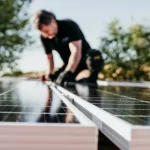Calculate your benefit
Yield of solar panels
Financial benefits of solar energy
Would you like to calculate the yield of solar panels? By default, this is done using the number of kilowatt hours (kWh). Monitoring the yield from solar panels is increasingly done in real time. This way, you will know exactly how much solar energy your solar panels generate on both sunny and cloudy days. And that is often even more than you think. The actual yield of solar panels depends on quality and peak power as well as external factors that are not always under your control. We will tell you more about solar panel yield calculations.

Yield of solar panels
A handy rule of thumb for calculating the yield of solar panels is the formula: average capacity × peak power. The average capacity of a solar panel is around 88% in the United Kingdom. This is due to differences in the orientation and pitch of the roof as well as variable weather conditions and panel quality. If you know the peak power of the panel (say 390 Wp), you can quickly calculate the yield from solar panels.
Sample calculation
Suppose you have 10 solar panels each with a peak output of 390 Wp installed on your roof. We take the average capacity of 88%. This leads to the following yield from solar panels:
Watt peak | 10 × 390 = 3,900 Wp
Average capacity | 0.88 kWh
Yield of 10 solar panels | 3,900 × 0.88 = 3,432 kWh
Yield at 34p per kWh | £1166,88 per year
*refers to a calculation example. No claims can be derived from this.
Lease or buy solar panels
What happens to your yield?
At Soly, you can choose to lease or buy solar panels, we not only calculate solar panel yield but also look at the cost. This gives you the best representation of the actual yield and the expected payback period. Both concepts involve a substantial difference in both cost and yield.
Purchase solar panels
Complete ownership
Purchasing solar panels means you get to own the entire system directly. An investment you will definitely recoup in the years to come. Even better: from day one, you start saving 100% thanks to 100% renewable solar energy. You will pay for the complete system up front. This makes the cost slightly higher but you will save more money on energy bills every year to come.
Rent solar panels
Subscription to the sun
If you choose to rent solar panels, you will not have to pay any initial costs. This is particularly interesting when you do not have sufficient funds to purchase a complete solar system. As a result, the cost is zero. However, you will save slightly less on energy bills. There is no payback period with solar panel rentals because you start saving from the first day without investing a cent.
Yield of solar panels per month
Would you like to know what your potential energy bill savings will be based on the number of solar panels you choose? This is quite simple. At Soly, we still take into account an average electricity price of 34p per kWh. However, that price is currently much higher. In our sample calculation, we have therefore taken into account a less favourable representation of reality. The yield of solar panels is becoming ever higher under pressure from current energy prices. Solar panels are thus becoming increasingly more interesting for you.
Solar panel yield formula
- Per year: number of solar panels × Watt peak × average capacity
- Per month: number of solar panels × Watt peak × average capacity/12
- Per day: number of solar panels × Watt peak × average capacity / 365
Naturally, the yield from solar panels varies depending on the time of year. This is partly due to the number of hours of sunshine, which is higher in summer than in winter. However, it does give a good indication of the potential yield from solar panels.
Background


